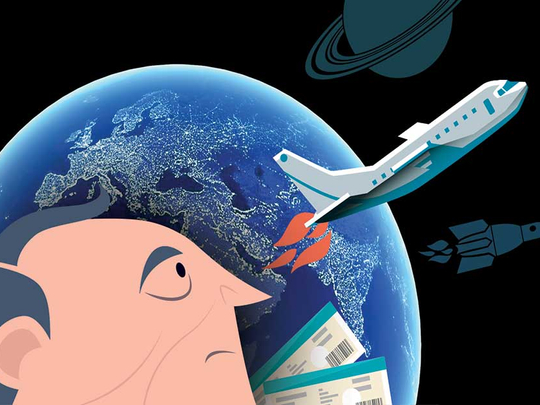
Last week, the Government of the United States (through its federal aviation agency) granted Virgin Galactic a licence to operate a commercial venture to take humans (and satellites) to nearby space. The fascinating space tourism vision is back on track, after suffering a serious setback when a prototype spacecraft from this same company crashed during a test-flight in late 2014. Before granting the licence, the US federal aviation agency carried out an extensive review of the detailed plans that were submitted — particularly the flight design, trajectory, safety and emergency procedures.
So who will go to space now and when?
Space tourism is actually not new. Seven customers have already gone to space, between 2001 and 2009. They were taken to the International Space Station by the Russian space agency. They each paid $20 million (Dh73.56 million) to $40 million to spend a week or so there, doing whatever they wanted to do. But now the price has dropped considerably: Virgin Galactic’s ticket now goes for “only” $250,000 per person — raised from $200,000 initially — and 700 people have already paid deposits to book a seat! A trip onboard Virgin Galactic’s SpaceShipTwo aircraft will only take people on a “sub-orbital flight”, taking them up to an altitude of 100-160km and bringing them back in a few hours. During that trip, the space tourists will get a few minutes of weightlessness and great views of Earth below and the cosmos beyond ...
This may seem extravagant, but there is in fact quite a bit of enthusiasm among the general public for the idea. A recent survey found that 70 per cent of respondents supporting the idea and dreaming to get the chance, are indeed asking for a greater and more amazing experience by adding space walks, in particular, to the itinerary. Others decry the prohibitive price tag, deeming the experience a luxury for the super-rich and pointing towards some drawbacks to the venture.
Indeed, a recent study considered the environmental impact of many space flights — assuming the idea takes hold and flights are carried out very frequently. The study estimated that 1,000 space flights would release 600 tonnes of black carbon into the higher atmosphere and this would produce an asymmetric global warming, decreasing the temperature in the Southern Hemisphere on an average by about a quarter of a degree and increasing it in the Northern Hemisphere by up to a degree — which would be huge.
The space tourism advocates, however, have their own arguments. First, they say, such huge enthusiasm and vigorous activity on various fronts can only decrease the costs, thereby opening the field to larger segments of the population and enlisting a new generation of engineers, who will surely find not only cheaper, but safer and more environment-friendly solutions. Just like travelling by air became a norm, and people don’t think it extravagant to take a trip to Mount Fuji or to watch fjords and auroras in Scandinavia, within a decade or so, people will not think it unreasonable to plan a short trip to outer space either — whether to satisfy curiosity, to enjoy a new experience or to simply celebrate some special life moment or achievement.
Furthermore, Nasa and other big players, such as the Russian space agency, insist that travellers to space can really be regarded as temporary astronauts, taking part in whatever mission activity are planned. Indeed, Nasa and others reject the term “space tourist” and officially use “space flight participant”. They point out that the seven customers who spent several days on board the International Space Station between 2001 and 2009, did carry out some experiments, sometimes commissioned by professional labs or other parties.
Another company in the space tourism race, XCOR Aerospace, has actually launched a ‘Citizens in Space’ project, which started as a ‘Teachers in Space’ programme, where people are trained for the trip and entrusted with specific experiments or activities. This extends to space the “citizen science” trend, where amateurs carry out scientific tasks and contribute to scientific research.
Virgin Galactic is moving full-steam ahead, planning for and hoping to send first flights with satellites and perhaps people as early as next year. Other companies have been preparing to build space hotels and space islands: Bigelow Aerospace has already launched two inflatable habitat modules, with more coming soon as the Space Island Group has been working on plans for a Space Island Project. Surely, some plans are more realistic than others, but this only goes to show the significant enthusiasm that space tourism currently enjoys among both, companies as well as potential individual customers.
Humans have always been drawn to explore and go “where no man has gone before”. People want to experience everything that can be experienced: Diving, gliding, bungee-jumping, floating in zero-gravity, you name it. Most interestingly, every new exploration opportunity has led to important technological advances. Perhaps space tourism will do that, or least widen our view of the world and the cosmos.
Nidhal Guessoum is a professor of physics and astronomy at the American University of Sharjah. You can follow him on Twitter at: www.twitter.com/@NidhalGuessoum.









